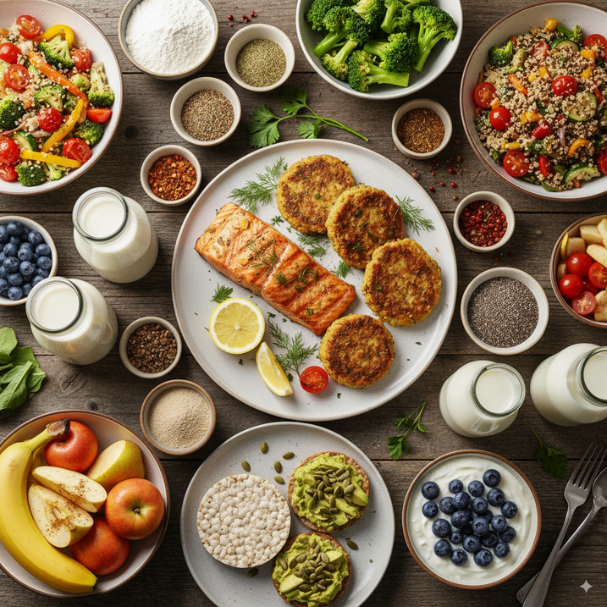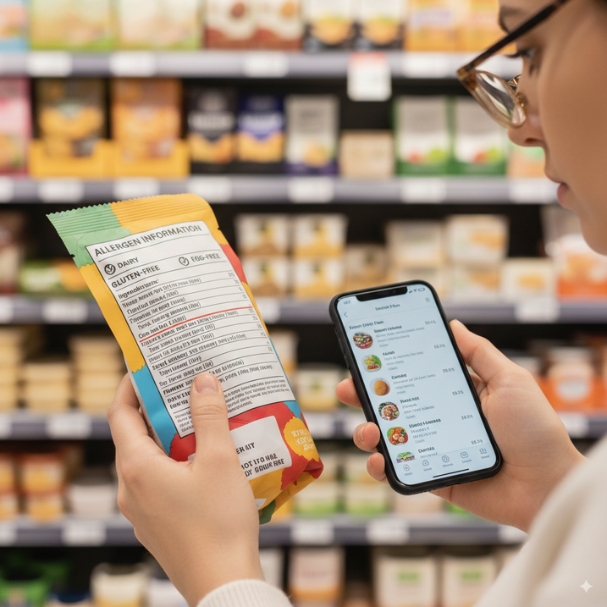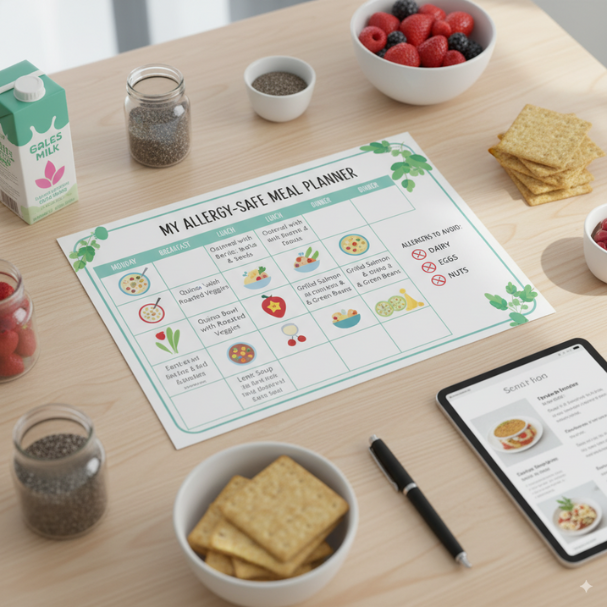Food allergies have become increasingly common across the world, and many people struggle to find a way of eating that allows them to enjoy meals safely without triggering allergic reactions. While some may experience mild discomfort after consuming an allergen, others may face more serious consequences. Creating a custom diet plan for food allergies is one of the most effective ways to manage this condition. Instead of following a general approach, tailoring a meal plan based on your unique needs ensures that you avoid harmful ingredients while still receiving essential nutrients.
Understanding Food Allergies
A food allergy occurs when the immune system mistakenly identifies a certain food as harmful and reacts to it. This response can range from mild itching or stomach discomfort to more severe reactions that may require medical attention. Common food allergens include dairy, eggs, peanuts, tree nuts, wheat, soy, fish, and shellfish. Even though these are the most frequent triggers, individuals can be allergic to almost any type of food. Because allergies vary from person to person, a generic diet plan rarely works for everyone, making customization vital.

When building a custom diet plan, the first step is identifying allergens that cause reactions. This can be done through allergy testing, food diaries, or professional guidance. Once you know what foods to avoid, you can start designing a plan that eliminates risks while providing balanced nutrition.
Why a Custom Diet Plan is Important for Food Allergies
Many people underestimate the role of personalization in diet planning. Unlike general nutrition advice, a custom diet plan focuses specifically on your health needs and food restrictions. Here are some reasons why a personalized plan is essential:
-
Safety: Avoiding allergens is crucial to prevent reactions. Custom plans remove dangerous foods and replace them with safe alternatives.
-
Nutrition balance: Cutting out certain foods can sometimes leave nutritional gaps. A tailored plan ensures you still get enough vitamins, minerals, protein, and healthy fats from alternative sources.
-
Sustainability: Following a diet that aligns with your tastes, preferences, and cultural food habits makes it easier to stick to in the long run.
-
Variety: Customization helps you explore new foods and recipes so that your diet doesn’t feel repetitive or boring.
Steps to Create a Custom Diet Plan for Food Allergies

Designing a diet that works for your specific needs requires careful planning. Below are the key steps to follow:
1. Identify Allergens Clearly
The first and most critical step is to know exactly which foods cause allergic reactions. Keeping a food diary is useful here. Record everything you eat along with any symptoms that occur afterward. Over time, patterns become clear and can help pinpoint problem foods. Allergy testing with a healthcare provider can also confirm triggers.
2. Learn About Hidden Sources of Allergens
Many allergens hide in foods where you least expect them. For example, wheat may be found in sauces, soy in snacks, or dairy in processed foods. Reading ingredient labels carefully becomes a daily habit. Familiarize yourself with alternate names of allergens—for instance, casein or whey for dairy, or albumin for egg. Awareness reduces the chance of accidental exposure.
3. Choose Safe Alternatives
Once you know what to avoid, the next step is identifying suitable replacements. For example, if you cannot consume dairy, plant-based milk options like almond milk, oat milk, or rice milk can be included. If you are allergic to eggs, flaxseed or chia seed mixtures work as good binders in baking. Gluten-free flours such as rice flour, millet flour, or buckwheat flour can replace wheat flour. By choosing alternatives, you keep your meals enjoyable while maintaining nutrition.
4. Balance Nutrients
Removing certain food groups due to allergies might reduce intake of essential nutrients. For example, if you are allergic to dairy, you may lack calcium and vitamin D. If you avoid nuts, you may miss healthy fats and certain minerals. A custom plan should compensate for these gaps by incorporating safe foods rich in similar nutrients. Leafy greens, fortified plant-based milk, seeds, legumes, and whole grains can help fill the nutritional void.
5. Plan Meals Ahead of Time
Meal planning reduces the stress of figuring out what to eat each day. Having a weekly plan that includes breakfast, lunch, dinner, and snacks prevents you from accidentally consuming unsafe foods. It also saves time, especially when you prepare allergen-free meals in batches and store them for convenience.
6. Experiment with Recipes
A custom diet plan for food allergies doesn’t have to feel restrictive. Experimenting with new recipes makes meals exciting and diverse. There are countless creative ways to cook allergen-free dishes using herbs, spices, and safe substitutes. This keeps your diet both enjoyable and nutritious.
Example Custom Diet Plan for Food Allergies

To help illustrate, here’s a sample diet plan. This is just a generic framework and should be adjusted according to individual needs and allergens.
-
Breakfast: Smoothie with oat milk, banana, spinach, and sunflower seeds (dairy-free, nut-free option).
-
Snack: Rice cakes topped with avocado and pumpkin seeds.
-
Lunch: Quinoa salad with roasted vegetables, chickpeas, and olive oil dressing.
-
Snack: Fresh fruit such as apple or pear with a sprinkle of cinnamon.
-
Dinner: Grilled salmon (if not allergic to fish) or lentil patties with steamed broccoli and sweet potato.
-
Dessert: Coconut yogurt with blueberries.
This type of plan avoids allergens while still being flavorful, balanced, and easy to prepare.
Tips for Following a Custom Diet Plan Successfully
Educate Yourself on Ingredients
Knowledge is your best defense. Learn to read labels thoroughly and research different terms used for allergens. The more you understand, the safer your food choices will be.
Cook More at Home
Restaurant meals can be risky since you may not always know how food is prepared. Cooking at home allows you full control over ingredients and preparation, ensuring safety.
Communicate When Eating Out
If you do dine at restaurants, inform the staff clearly about your allergies. Many places are willing to adjust meals if they understand the seriousness of the situation.
Keep Meals Simple
Sometimes the simplest meals are the safest. Fresh vegetables, fruits, whole grains, and lean proteins prepared in uncomplicated ways reduce the risk of hidden allergens.
Rotate Safe Foods
Eating the same allergen-free foods repeatedly may lead to nutrient deficiencies or new sensitivities. Rotating different safe foods keeps your diet balanced and varied.
Common Challenges and How to Overcome Them
Following a custom diet plan for food allergies is rewarding but can come with challenges.
-
Limited food options: Initially, it may feel like there aren’t many safe choices. Solution: Explore global cuisines that naturally avoid your allergens and discover new dishes.
-
Nutritional gaps: Eliminating allergens can reduce certain nutrients. Solution: Include fortified foods and natural sources that replace lost nutrients.
-
Social gatherings: Events with shared meals can be stressful. Solution: Bring your own allergen-free dish so you have safe options.
-
Hidden allergens: They can sneak into sauces, seasonings, and packaged foods. Solution: Always double-check labels and ask questions when unsure.
Benefits of a Custom Diet Plan for Food Allergies

The benefits go beyond simply avoiding allergic reactions. A well-structured plan also helps improve digestion, energy levels, and overall well-being. Eating safe foods reduces the constant anxiety of accidental exposure, making you feel more confident about your lifestyle choices. Over time, you also discover new ingredients, expand your cooking skills, and enjoy meals that are both safe and delicious.
The Role of Mindful Eating in Food Allergies
Mindful eating plays a significant role when following a custom diet plan. Paying attention to how your body responds to certain foods helps in understanding what works best for you. By eating slowly, observing symptoms, and noting how you feel afterward, you can fine-tune your diet further.
Final Thoughts
Living with food allergies doesn’t mean sacrificing flavor, nutrition, or the joy of eating. The key lies in creating a custom diet plan that avoids allergens while ensuring that your body gets the nourishment it needs. By identifying allergens, choosing safe alternatives, balancing nutrients, and planning ahead, you can enjoy a wide variety of delicious meals without fear. With knowledge, creativity, and preparation, managing food allergies through a personalized diet becomes a sustainable lifestyle that supports long-term health and well-being.




